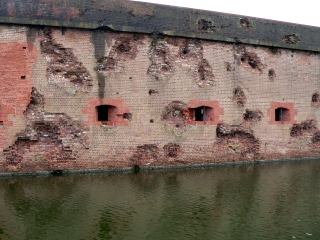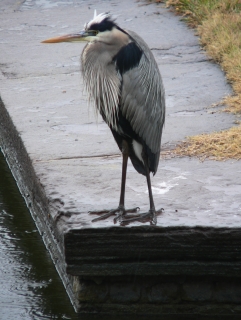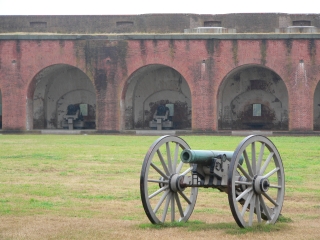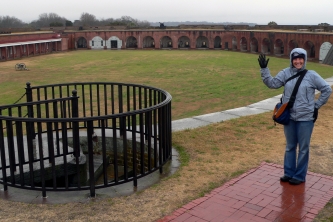NPS Website; Local Website
 WHAT IS IT?
WHAT IS IT?One of 30 coastal forts built after the War of 1812 to protect the United States from foreign naval invasion. Fort Pulaski saw its only action early in 1861, during the start of the Civil War.
BEAUTY (6/10)
The pentagonal Fort Pulaski has not changed much since its construction. Its estimated 25 million red bricks and 7 1/2-foot thick led many to believe the Fort was invincible. The exterior of the south and southeastern walls prove otherwise. Large indentations and some mortar shells remain from when the Union troops successfully bombarded and captured the Confederate stronghold.
HISTORICAL INTEREST (8/10)
The Site boasts that military history changed forever at Fort Pulaski. The Union army’s use of its new invention, the rifled cannon, allowed them to easily breach the thick walls after just 30 hours. The 30 forts of the Third Coastal Defense system were suddenly obsolete after facing just one collective attack.
After the Yankees secured Fort Pulaski, their commander, General Hunter declared its inner sanctum to be a free zone for local slaves. This move pre-empted the Emancipation Proclamation by seven months and came in defiance of Abraham Lincoln’s public order. Many of the freed slaves who made it to Fort Pulaski joined the Union Army and fought as the First South Carolina Colored Regiment.
Fort Pulaski NM is made even more interesting with its endless small stories skillfully told our Ranger tour guide, the video and the Museum. Baseball’s founder was stationed here and organized one of its first games inside the grounds. Union General Hunter was from the South and did not become an abolitionist until after the war began. Robert E. Lee, as a young Engineer, worked on the Fort’s design and later, just prior to the Battle, mistakenly believed that it could not be attacked from Tybee Island (where the Union was stationed). He did not know about the rifled cannon.
In a completely unrelated historical note, Fort Pulaski rests on the tiny Cockspur Island, the same Island where John Wesley, founder of Methodism, first landed in the United States in 1736. It is said that he preached in the same live oak forest.
 CROWDS (6/10)
CROWDS (6/10)A Jacksonville native escaping the Super Bowl was the only other person on our tour of the Fort. Because the group was so intimate, the Ranger took us out of the rain and through some of the rooms not normally open to the public. An unexpected treat.
EASE OF USE/ACCESS (3/5)
The Site is 15 miles due east along U.S. Route 80 from downtown Savannah, the city it was built to protect.
CONCESSIONS/BOOKSTORE (4/5)
The usual Civil War tomes are here, but so are at least six titles specific to Fort Pulaski, a large selection dedicated to the African American experience and one illustrated book that had Gab glued to the spot until she read it cover to cover. Songs from the Underground Railroad were playing quietly in the background; the space was warm and nicely lit. One of us could have stayed here all day.
COSTS (3/5)
Entry is $3 per adult or free with the National Parks Pass.
RANGER/GUIDE TO TOURIST RATIO (4/5)
We noticed more people in NPS uniforms than visitors. Hard to say how many were actually interpretive Rangers.
TOURS/CLASSES (9/10)
In the summer months, Rangers give five tours a day of the Fort. That number is pared down to two in the off-season. We wandered into the Fort for the 11:00am tour, braving the 40º temperatures and cold rain. At 11:05, we were still alone. A Ranger popped his head out of his office and asked if we had any questions.
 The resulting 45-minute tour of the Fort was an unforeseen pleasure. He was not an interpretive Ranger and did not have a script memorized. Instead, he told us stories, showed us hidden places and answered many questions.
The resulting 45-minute tour of the Fort was an unforeseen pleasure. He was not an interpretive Ranger and did not have a script memorized. Instead, he told us stories, showed us hidden places and answered many questions.15 minutes after he had started, another Ranger (the scheduled tour guide) ran into the Fort and announced that the 11:00 tour was cancelled because of inclement weather. His proclamation seemed silly to all of us while we were learning about the Union and Confederate use of human shields at the Fort. We greatly appreciated the Fort Pulaski Ranger’s generosity, not to mention his teaching acumen. He did not have to help us but he did.
The newly redone introductory video is excellent. Go see it before you make your way into the Fort. The small museum is also a treat. Fascinatingly designed original flags hang from the rafters behind protective glass. Notable among them is the familiar coiled snake “Don’t Tread on Me” South Carolina flag and one showcasing a menacing eagle labeled “Federal Government” attacking a pristine woman labeled with the names of the Confederate States. The message reads, “Touch her if you dare”.
FUN (7/10)
A series of disappointing Sites made us wary of yet another coastal fort. Oh look, some earthworks, and how about that cannon? Fort Pulaski NM distinguished itself with a small but excellent museum, a video that aided rather than obstructed our understanding of the Site and a Ranger that went out of his way to ensure that the few visitors to the Site didn’t leave without a tour.
And how about that cannon? The artillery that rests in the corner of the south and southeast walls actually saw action during the 1862 siege. It looks worse for wear, but not as bad as the walls themselves. Fort Pulaski NM bears the scars of the innovations in weaponry that made the Civil War our first modern war.
 We enjoyed this outdoor site, even in the pouring rain. We did not intend to spend three hours here but we did.
We enjoyed this outdoor site, even in the pouring rain. We did not intend to spend three hours here but we did.WOULD WE RECOMMEND? (7/10)
Facilities and staffing at Fort Pulaski NM are superior to Fort Frederica NM and Fort Caroline NMEM. With its close proximity to Savannah, Fort Pulaski NM is an easy side trip and a good reason to explore the beaches of Tybee Island.
TOTAL 57/80
www.usa-c2c.com
© 2004-06